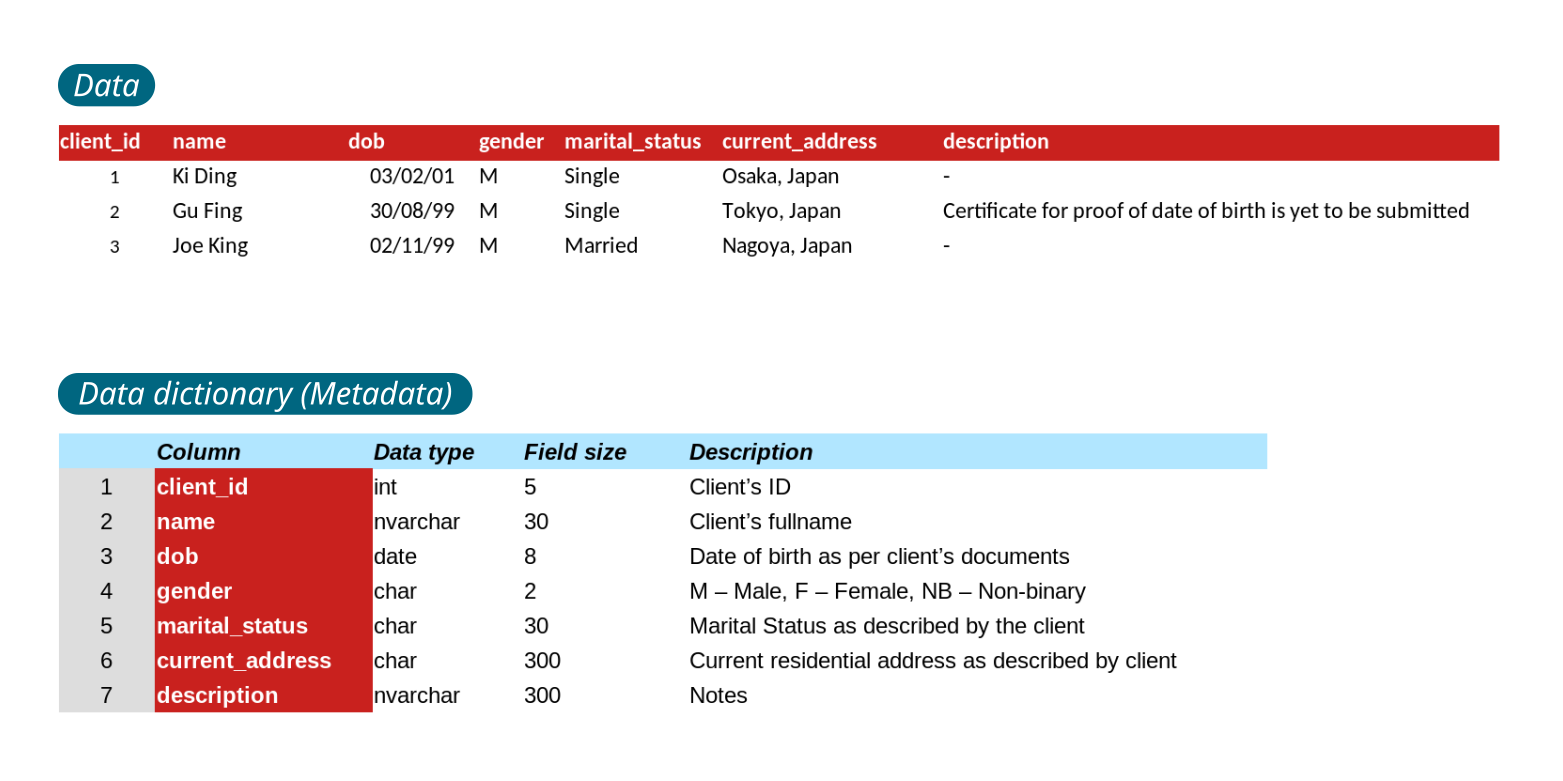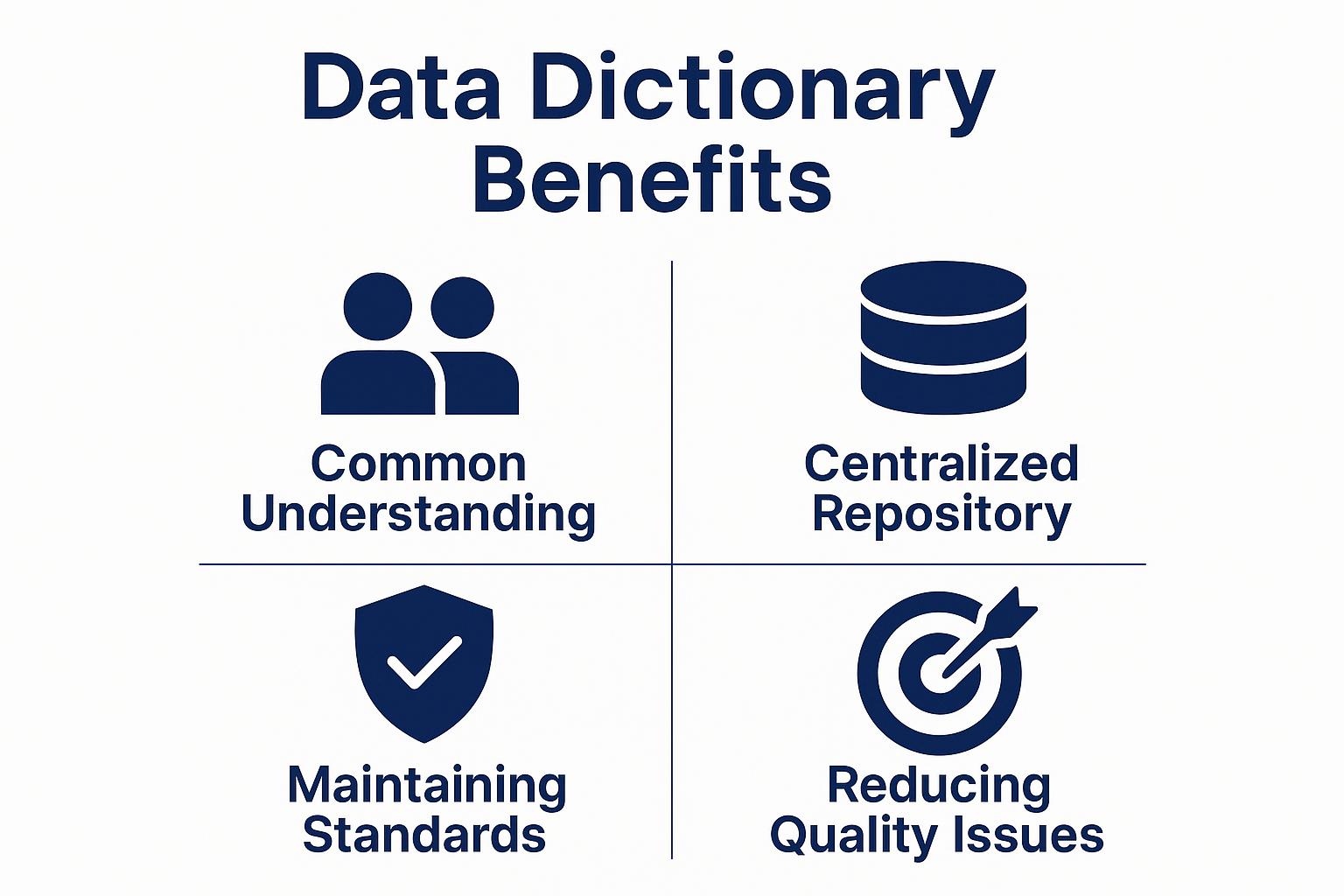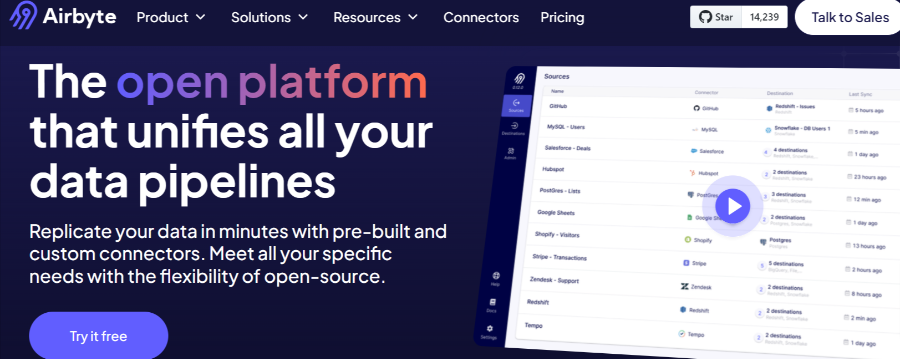What is Data Dictionary: Examples, Best Practices, & Importance
Summarize this article with:
✨ AI Generated Summary
The foundation of successful data management lies in establishing clear, consistent documentation of your data assets. This is where data dictionaries become indispensable, serving as the authoritative source that transforms chaotic data landscapes into organized, trustworthy information systems that drive business value.
This comprehensive guide will cover everything you need to know about implementing and maintaining effective data dictionaries in modern data environments.
TL;DR: Data Dictionary at a Glance
- A data dictionary is a centralized repository that provides detailed definitions, metadata, and relationships for all organizational data elements
- Key benefits include reduced data integration costs, improved data quality, enhanced compliance, and streamlined collaboration between technical and business teams
- Essential components encompass data elements, metadata, relationships, ownership information, and integration with modern data governance frameworks
- Modern implementations leverage AI-driven automation for scalability and integrate with platforms like Airbyte for seamless data integration workflows
- Successful deployment requires DAMA-DMBOK framework alignment, stakeholder engagement, and systematic governance processes for enterprise-scale adoption
What Is a Data Dictionary and Why Does Your Organization Need One?

A data dictionary is a repository that contains detailed information about an organization's data. It provides a clear and concise definition of each data element, making it easy to understand and use the data effectively. Beyond simple documentation, a modern data dictionary serves as the cornerstone of data governance, enabling organizations to maintain consistency, ensure quality, and facilitate collaboration across teams.
In today's data-driven landscape, where organizations manage exponentially growing volumes of information from diverse sources, a data dictionary prevents the chaos that emerges when teams operate with different interpretations of the same data elements. It bridges the communication gap between technical and business users, ensuring everyone speaks the same data language.
What Benefits Does a Data Dictionary Provide for Your Enterprise?
A data dictionary is useful across your organization because it provides a standardized source for understanding and storing data. It stores crucial information, such as the definition of data types and attributes, while delivering measurable business value through improved operational efficiency.

- Common Understanding: A data dictionary helps you and every member of your organization understand your database's underlying design, structure, and relationships between data. This shared understanding reduces miscommunication and prevents costly errors that arise from data misinterpretation.
- Centralized Repository: It creates a centralized location, making data easily accessible and saving time spent on data discovery. Rather than hunting through multiple systems or relying on tribal knowledge, teams can quickly locate and understand the data they need.
- Maintaining Standards: A well-established data dictionary makes it easy for you to maintain database management systems and programming standards. Consistent naming conventions and data definitions across your organization prevent integration conflicts and simplify system maintenance.
- Reducing Data Quality Issues: Having a data dictionary allows you to perform data integrity checks quickly, eradicating quality issues. By establishing clear definitions and constraints, you can identify anomalies and inconsistencies before they propagate through your systems and impact business decisions.
What Are the Essential Components of a Data Dictionary?
The content and structure of a data dictionary vary depending on the industry and its requirements. However, a few key components are staples for most businesses. Here are some of the most common components in a data dictionary:
- Data Elements: A data element is a basic unit of information that defines each data item's context within your business. Data elements should have distinct values and be easy to understand. Each element represents a specific piece of information that carries business meaning and operational significance.
- Data Element Name: These are labels used to identify each data element. The names should be descriptive and follow the naming conventions established by your organization. Consistent naming prevents confusion and enables automated processes to work reliably across different systems.
- Metadata: Metadata refers to information about the database, such as when it was created, who created it, when it was last updated, and more. This contextual information helps users understand the currency and reliability of the data they're working with.
- Data Element Attributes: Additional details about individual data elements, including their size, format, range of values, and type. These technical specifications ensure proper data handling and enable validation rules that maintain data quality.
- Relationships: Describes how different data elements relate to one another—for example, which tables contain foreign keys that reference primary keys in other tables. Understanding these connections is crucial for maintaining referential integrity and building effective queries.
- Data Owner and Steward Information: Owners and stewards are responsible for ensuring the data's accuracy, completeness, and security. Clear ownership assignments enable accountability and provide contact points for data-related questions or issues.
- Data Usage Information: Understanding how data will be used is crucial for designing appropriate storage mechanisms and establishing proper controls around access and sharing. This component helps optimize performance and ensure compliance with privacy regulations.
- Data Source Information: Knowing where data comes from is the key to understanding its reliability and relevance. Source tracking enables data lineage analysis and helps assess the trustworthiness of different data sets.
- Data Objects: Entities such as tables, views, indexes, and schemas that provide a structured and comprehensive description of the data. These objects form the building blocks of your data architecture and define how information is organized and accessed.
What Is an Enterprise Data Dictionary and How Does It Scale?
An Enterprise Data Dictionary (EDD) provides a unified overview of an organization's data assets. It serves as the primary source for data definition, metadata, relationships, and usage across the entire enterprise. Unlike departmental or project-specific dictionaries, an EDD encompasses all data domains and business functions within the organization.
EDD contains both business and technical definitions of data elements, allowing for a common understanding between different departments and users. It includes data element names, descriptions, data types, formats, and applicable business rules or constraints. This dual perspective ensures that both technical implementers and business stakeholders can effectively utilize the dictionary for their specific needs.
Enterprise data dictionaries must scale to accommodate thousands of data elements across multiple systems, domains, and geographies. Modern EDDs incorporate automated discovery capabilities, workflow management for updates, and integration with existing data governance tools to maintain accuracy and completeness at scale.
A few benefits of EDD include improved data quality, easier access to trusted data, reduced data redundancy, and consistency in data usage across the organization. Additionally, enterprise-scale dictionaries enable regulatory compliance, risk management, and strategic data initiatives by providing the foundational documentation necessary for these programs.
How Do Data Catalogs, Data Dictionaries, and Business Glossaries Work Together?

The key differences between a data catalog, a data dictionary, and a business glossary are their scope, audience, and purpose. Understanding these distinctions helps organizations implement the right combination of tools for comprehensive data management.
A data catalog provides a detailed inventory of an organization's assets, aiding technical and business users in data discovery and governance. In contrast, a data dictionary is more technical, detailing metadata about data elements, which IT professionals primarily use for data management and integration. A business glossary, on the flip side, focuses on defining business terms and concepts, ensuring consistent terminology and understanding across non-technical departments.
While each serves distinct purposes, they work synergistically to create a comprehensive data knowledge ecosystem. The data catalog helps users discover relevant data assets, the data dictionary provides technical implementation details, and the business glossary ensures everyone understands the business context and meaning.
How Can AI-Driven Automation Enhance Data Dictionary Scalability?
Traditional data dictionaries face scalability challenges due to manual upkeep, evolving data ecosystems, and the exponential growth of data sources. As organizations deploy multimodal AI systems and edge computing infrastructures, human-driven metadata curation becomes impractical. AI-powered automation addresses this by enabling real-time discovery, contextual mapping, and adaptive learning for data dictionaries.
Implementing AI-Enhanced Dictionary Management
- Generative Metadata Synthesis: Large language models can infer contextual definitions for undocumented fields by analyzing data patterns, lineage, and adjacent metadata. Modern platforms leverage LLMs to generate draft dictionaries from project descriptions and exploratory data analysis outputs. For example, an LLM might analyze customer interaction logs to propose a structured definition for "sessionengagementscore," including allowed ranges, relationships to behavioral metrics, and compliance flags.
- Predictive Quality Control: AI models proactively identify inconsistencies such as deprecated fields, naming conflicts, or outlier values by comparing dictionary entries against live data pipelines. Reinforcement learning agents can then auto-correct entries or trigger alerts for data stewards. Organizations report significant reductions in reporting errors after implementing AI-assisted anomaly detection in their data dictionaries.
- Self-Updating Frameworks: Integration with orchestration tools allows dictionaries to sync with database migrations, CI/CD pipelines, or schema evolution events. Real-time validation against data contracts ensures dictionaries reflect ground truth. This automation reduces technical debt by handling routine maintenance tasks, freeing stewards for higher-order governance activities.
What Role Do Knowledge Graphs Play in Modern Data Dictionary Implementation?
Data dictionaries historically documented attributes in isolation, lacking semantic relationships or domain context. Semantic data dictionaries bridge this gap by anchoring metadata to formal ontologies and integrating with enterprise knowledge graphs. This enables dictionaries to capture not just column definitions but conceptual meaning, entity relationships, and cross-dataset equivalences.
Technical Implementation of Semantic Enhancement
- Ontological Alignment: Semantic data dictionaries use structured mapping tables to bind columns to ontological classes and define relational predicates. Tools automate this via declarative templates, exporting metadata as RDF triples for graph database ingestion. For example, a healthcare semantic data dictionary might map "patientdiagnosiscode" to SNOMED CT ontology terms, linking it to related concepts like symptoms or medications while enforcing industry standards.
- Contextual Disambiguation: Multilingual or polysemous terms are resolved using contextual embeddings from knowledge graphs. Advanced NLP methods align terms across different languages and contexts, reducing ambiguity in multilingual data stacks. This capability becomes crucial for global organizations managing data across different regions and languages.
- Graph-Native Governance: Data dictionaries embedded in knowledge graphs support inferential queries and dynamic compliance checks against regulatory ontologies. Users can ask complex questions like "Which datasets contain attributes derived from geolocation?" and receive comprehensive answers that consider both direct and indirect relationships.
Advantages for Modern Data Architecture
In decentralized architectures like Data Mesh, semantic dictionaries serve as contractual frameworks that harmonize domain-specific terminology across teams. When marketing defines "customerltv" and sales uses "clientrevenue_value," ontology-backed dictionaries identify equivalence, enabling federated queries without central mediation. Organizations attribute faster data product integration to semantic dictionaries that pre-negotiate schema alignments via shared ontologies.
What Are Proven Examples of Effective Data Dictionary Implementation?
A data dictionary is a crucial tool for managing and understanding data within various industries. Here are five data dictionary examples that demonstrate different approaches and use cases.
- MicroStrategy Intelligence Server Statistics Data Dictionary: MicroStrategy's data dictionary contains performance metrics and objects related to the Intelligence Server, including definitions for each metric and explanatory notes. This enterprise example demonstrates how technical performance data requires precise documentation to enable system optimization and troubleshooting.
- American Time Use Survey Data Dictionary: The Bureau of Labor Statistics data dictionary describes the variables used in the American Time Use survey. It allows researchers to understand how variables are coded and the meaning of each item. This government example shows how standardized definitions enable reproducible research and policy analysis.
- ORNL Health Risk Assessment Data Dictionary: Oak Ridge National Laboratory (ORNL) maintains a data dictionary as a PDF that resembles a detailed index at the end of a book. The document provides basic information (entry type and description) on each entry, called a variable. This scientific example illustrates how specialized domains require domain-specific terminology and constraints.
- NASA's Planetary Data System (PDS) Data Dictionary: NASA's PDS data dictionary is a comprehensive resource that contains metadata for various planetary objects. You can easily search through metrics and data quality indicators for planetary data. This example demonstrates how large-scale scientific programs require sophisticated search and discovery capabilities within their dictionaries.
How Should You Create a Comprehensive Data Dictionary?
Creating a data dictionary involves several key steps to ensure it is comprehensive, accurate, and aligned with your organization's needs. The process requires systematic planning, stakeholder involvement, and ongoing maintenance to deliver lasting value.
Build Your Data Dictionary Foundation
- Create a Team of Data Experts: Form a team of data owners, subject matter experts, data stewards, and data governance professionals. This team will be responsible for developing, maintaining, and enforcing the data dictionary. Include representatives from different business domains to ensure comprehensive coverage and buy-in across the organization.
- Consolidate Data from All Sources: If you have several databases in different locations, identify all data assets in your organization and bring them to a central location. However, manually integrating all organizational data from different systems is time-consuming and inefficient. A better approach is using a data integration tool like Airbyte, which helps you swiftly conduct data integration.

Airbyte is a modern data movement platform designed to seamlessly integrate data from various sources into a single repository. This consolidation step is crucial because a comprehensive data dictionary requires visibility into all organizational data sources.
Key features include:
- Pre-built Connectors: Over 600+ pre-built connectors for rapid, no-code integration.
- Change Data Capture: CDC for real-time synchronization of data changes.
- CDK: A Connector Development Kit for building custom connectors in minutes.
Document and Standardize Your Data Elements
- Document All Data Elements: Identify and document each data element's attributes including name, description, data type, format, owner, usage, constraints, and relationships. This documentation forms the core content of your data dictionary and requires attention to detail and consistency.
- Standardize All Data Components: Establish a standardized naming convention, structure, and taxonomy for data components and their properties. Consistency in naming and organization makes the dictionary more usable and maintainable over time.
Deploy and Maintain Your Data Dictionary
- Select Your Data Dictionary Tool: Choose a tool whether spreadsheets, documents, or data cataloging software to store and manage your data dictionary. Consider factors such as scalability, collaboration features, search capabilities, and integration with existing systems when making your selection.
- Make the Data Dictionary Accessible: Deploy the data dictionary so all key stakeholders can access it. Provide training and documentation to help users understand how to use it effectively. Accessibility includes both technical access and user education to ensure adoption across the organization.
- Maintain and Update Regularly: Implement best practices such as clear definitions, periodic assessments, and regular updates. Assign dedicated data stewards and collect user feedback for continuous improvement. Regular maintenance ensures the dictionary remains accurate and valuable as your data landscape evolves.
Conclusion
A data dictionary is an essential tool for managing and utilizing data assets effectively in today's complex data environments. The investment in creating and maintaining a comprehensive data dictionary pays dividends through improved data quality, reduced development time, enhanced compliance capabilities, and better decision-making across the organization. As data volumes continue to grow and regulatory requirements become more stringent, the role of data dictionaries as the authoritative source for data understanding becomes increasingly critical.
Frequently Asked Questions
What is an example of a data dictionary?
NASA's Planetary Data System (PDS) contains technical information, metadata, and data type information on various planetary data, demonstrating how scientific organizations document complex datasets for research and analysis purposes.
What is a data dictionary in healthcare?
A data dictionary in healthcare contains metadata for standard medical procedures and treatment plans used within healthcare information systems. It ensures consistent terminology across electronic health records, clinical research, and regulatory reporting while maintaining HIPAA compliance and patient privacy requirements.
What are two types of data dictionaries?
Active and passive. An active data dictionary is integrated within the DBMS and updates automatically when database structures change, while a passive data dictionary is maintained separately and requires manual updates to reflect system changes.
What makes a good data dictionary?
Timeliness, consistency, accuracy, and completeness combined with regular updates to reflect any changes in the database. Additionally, good data dictionaries include clear definitions, comprehensive metadata, proper governance processes, and accessibility features that serve both technical and business users.
Can Airbyte be used for creating a Business Glossary and Data Dictionary?
Yes. Airbyte consolidates data from multiple databases into a central repository, making it easier to build both a business glossary and a data dictionary. The platform's comprehensive connector ecosystem and metadata management capabilities provide the foundation for documenting and understanding data assets across the organization.
How to create a referable data dictionary?
Involve all stakeholders, choose an accessible tool, update it regularly, and share it with new members to ensure widespread adoption. Additionally, implement clear governance processes, establish ownership responsibilities, and create user training materials to maximize the dictionary's value and usage.
Is it unwise to save mismatched data types in a dictionary?
Yes. Mismatched data types can compromise consistency and integrity, leading to confusion across the organization. Proper data type documentation prevents integration errors, ensures accurate analysis, and maintains the reliability of automated processes that depend on consistent data structures.

.webp)
